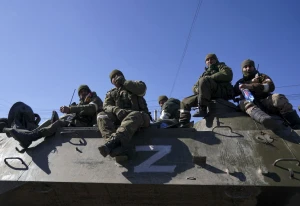
Russia is evolving, situation is tense: hostilities in Kharkiv region. Serhiy Zgurets’ column
Discussing NATO's nuclear strategy changes, the course of hostilities in the Kharkiv region, and the achievements of the Third Separate Assault Brigade
NATO nuclear weapons
NATO countries are considering deploying more nuclear weapons due to the rising threats from Russia and China, according to NATO Secretary General Jens Stoltenberg in an interview with the Telegraph. He mentioned that the alliance is discussing moving missiles from storage to combat readiness, emphasizing nuclear transparency as a key deterrent. Despite some inaccuracies in the article, Stoltenberg's statements are crucial as they reflect NATO's response to Kremlin threats of nuclear weapon use against Ukraine and Europe.
Oleksiy Yizhak, an analyst at the National Institute of Strategic Studies, noted that Europe used to have a significant number of nuclear weapons, which were later reduced through decisions on medium and short-range missiles and separate agreements to cut the nuclear arsenal.
"A lot of these weapons, including artillery and mines, were destroyed, but some, like the Tomahawk ground version warheads, were only partially destroyed and moved to reserve. The US now has a new generation of missiles, and discussions are likely about where to deploy them. Until recently, these intermediate-range missiles were mainly intended for the Far East, with planning starting from the Korean War. Now, with China and Russia building up their arsenals, I think, NATO seems to recognize that the Russian arsenal might be linked to China," Yizhak explained.
Yizhak said it's unclear if the material concerns missiles or warheads: "This isn't a plan or decision yet. We'll see what's in the Washington Summit decisions. It's a reminder to Russia that both missiles and nuclear warheads aren't exclusive to Russia and China."
He broke down the nuclear force structure: "Strategic nuclear forces, which are always ready to fly and fire, are on constant alert: command, and they fly, fire. There's also a lower readiness level, like re-equipping an F-35, which isn't quick. Then there's the reserve, stored and ready but without carriers. With China and Russia uniting their nuclear arsenals, the U.S. must prepare to balance by considering both Russia and China."
The analyst highlighted that NATO's discussing of nuclear weapons is the news, given the U.S. discussed it last year: "This is a new and interesting development."
Kharkiv region situation
In the Kharkiv direction, Russian forces have renewed their attacks, particularly near Vovchansk. Major Rodion Kudryashov, deputy commander of the 3rd Separate Assault Brigade of the Ukrainian Armed Forces, reported that the situation remains tense.
"For a month, the enemy has been focusing all efforts in our direction. According to intercepted intelligence, we're a main target. They are trying to break through our defenses with all available forces and means. We see raiding assaults where the enemy uses both equipment and large numbers of infantry. Every day, their infantry storms our front lines in large and small groups. They haven't achieved operational success despite their efforts. The situation remains tense but under control," emphasized Kudryashov.
He added that Russia is adapting, trying to correct past mistakes.
"Now, all Russian assault units are well-equipped, with strong support and artillery. Their tactics haven't changed; they rely on two main advantages: abundant ammunition and unlimited human resources. After we neutralize one assault unit, they send the next one. This pattern has continued in our area of the front for a month now," stressed the major.
Is there a hierarchy among military personnel in the Ukrainian Armed Forces?
According to Kudryashov, the approach to combat tasks in the 3rd Brigade is unique.
"It all starts with the microclimate in the unit. Today, one of the main reasons for our effective work is communication. In our brigade, there are no, relatively speaking, separate desks for officers and soldiers. There's a normal microclimate with hierarchy and certain subordination. This builds trust among soldiers towards the middle and senior officers, who understand not just the task but its thorough planning, with all commanders being aware of the situation. The key is that we don’t just feel sorry for the soldiers, we protect them and work with this ideology," Kudryashov explained.
He shared that the same methods are used in Kraken, the separate reconnaissance and sabotage unit of the Military Intelligence Service, and the Azov NGU brigade.
"We must understand that war is very dynamic, with many changes during combat and a technical revolution on the front line. We are doing everything to minimize our personnel losses and organize their presence on the front line. Our brigade was one of the first to use unmanned systems extensively, both on the ground and in the air, which helps us perform combat tasks better, causing more damage and ensuring more safety for our personnel," he emphasized.
Kudryashov added that the brigade constantly changes staff and seeks new methods to execute combat missions.
"If the 3rd brigade isn't fighting, it's training and preparing for future missions. Even during combat, we make innovative changes in staff structures and planning to adapt to the battlefield's dynamics," concluded the major.
- News












































